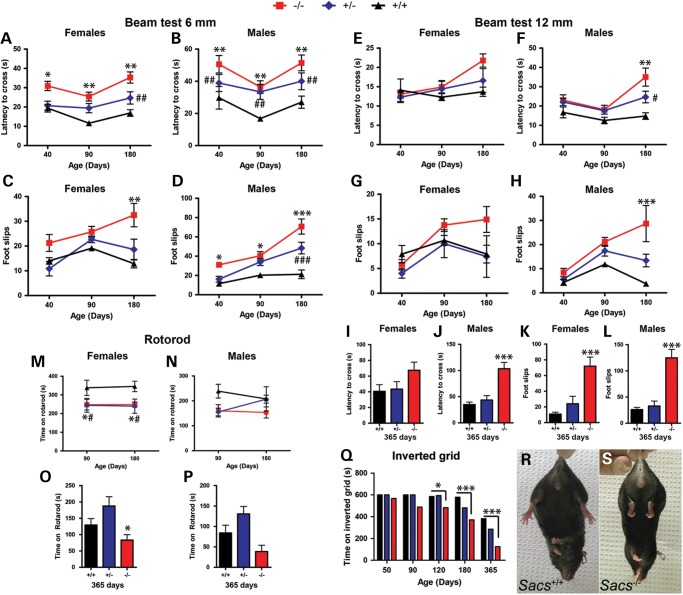Figure 1.
Sacs−/− mice display ataxia, motor deficit and muscle weakness. (A–P) Results of balance beam and rotorod tests of motor coordination for a first cohort of mice tested at 40, 90 and 180 days of age (A–D), (E–F), (M) and (N) and a second cohort tested at 365 days of age (I–L), (O) and (P). Deficits in both male and female mice as early as 40 days of age on the 6 mm beam test depicted by (A and B) increased latencies in crossing the beam and (C and D) increased number of foot slips. Heterozygous males also showed significant deficits compared with controls (A and D). (E–L) On the 12 mm beam, significant deficits were measured starting at 180 days for male (F), (H), (J) and (L) and at 365 days for female (K) Sacs−/− mice. (M and P) Significant motor deficit in Sacs−/− and Sacs+/− females compared with control mice on the accelerating rotorod test performed at 90, 180 (M and N) and 365 (O and P) days of age (M and O). Rotorod performance of Sacs−/− males was not significantly different from controls (N and P). (Q) Inverted grid test of mice at 50–365 days; significant muscle weakness in Sacs−/− females starting at 120 days of age compared with control mice. The difference between heterozygous mice and control was not statistically significant (P > 0.05). One-year-old Sacs−/− mice exhibited a hindlimb clasping reflex (S) rather than the normal plantar reaction (R). Data are presented as means ± SEM of three independent trials (n ≥ 7 females and n ≥ 6 males per group). −/− versus +/+: *P < 0.05, **P < 0.01, ***P < 0.005; +/− versus +/+: #P < 0.05, ##P < 0.01, ###P < 0.005 (two-way ANOVA with repeated-measures followed by Tukey's post hoc comparison of −/− or +/− versus +/+).

